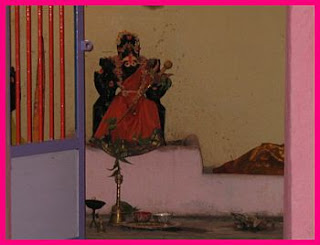Now that Tiruvannamalai is developing so quickly many people think of it as one town, but it is more a combination of many outlying villages. Those villages maintain their uniqueness in many ways, one of which is the worship and celebration of their village's Goddess.
The village is the special place of the deity. She is the mother or mistress of the village, as suggested by a name popular in the South, Amman; meaning, "mother, mistress, or lady". The close identity of the Goddess with her village is also seen in her role as guardian of the village's boundaries. Her shrines or symbols are often erected at the boundaries of the village, where she acts to protect it from invasions or evil spirits. She is the Goddess of the whole village, the physical place as well as the social and economic organism.
Today, June 19, 2007, is the yearly festival celebration of my local village Goddess, Mariyamman; and for several preceding few days there has been the hustle and bustle of preparation; the local shrine painted, tube lighting put up throughout and devotional music continously piped from loudspeakers at the Shrine.
Kids from the village are wandering from place to place checking out what's happening. There is festive spirit in the air and the kids are getting rowdy!

Below a young mother with her child coming out of their home to look at all the festival preparations.

This afternoon an iconic representation of the Goddess Karumariamman is taken in procession throughout what is regarded as the area of her power and jurisdiction. In the evening the iconic representation of the Goddess returns to her permanent residence at the village shrine. The below photograph is of a giant figure of the Mother lit up by thousands of light bulbs.

"Two of the best-known myths concerning the origin of the popular Goddess Mariyamman in South India are: In one version a young Brahman girl is courted by and eventually married to an untouchable who has disguised himself as a Brahman. On discovering the trick, the woman becomes furious and kills herself. She is transformed into a Goddess and in her divine form punishes the untouchable by burning him to ashes or otherwise humiliating or humbling him.
The second version of Mariyamman's origin identified her with an extremely pious, pure wife who is married to a devout holy man. She is so pure that she can perform miraculous tasks such as making jars out of loose sand and boiling water simply by placing a pot of water on her head. One day, however, she sees two divine beings making love and feels envious of them. Thereupon she loses her miraculous power. Discovering this and suspecting sexual disloyalty, her husband commands their son to kill his mother. The son obeys his father and decapitates his mother. Eventually she is restored to life, but in the process her head and body get transposed with those of an untouchable woman. Mariyamman is thus understood to have a Brahman head and an untouchable body, which is significant in terms of both her ambivalent nature and her role as a village Goddess exemplifying the social status quo in which Brahmans are at the had of the social system."
[Extract from Hindu Goddesses
By David Kinsley]

Interesting! We had Mariyamma festivals in Andhra Pradesh too, but I never knew the story behind it.
ReplyDelete